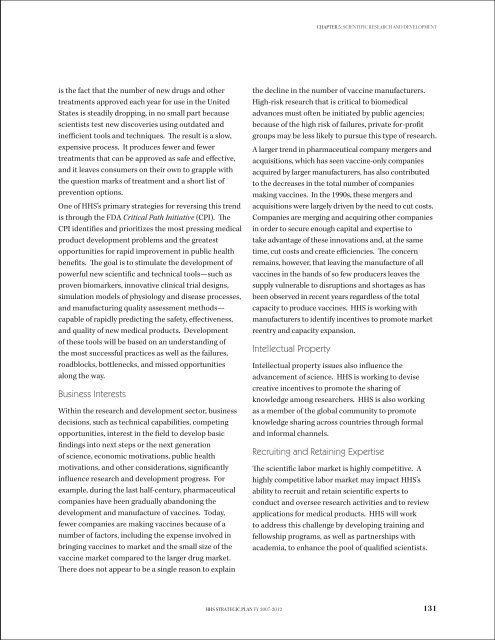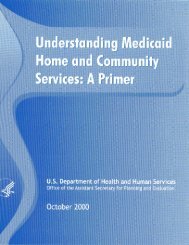STRATEGIC PLAN - ASPE - U.S. Department of Health and Human ...
STRATEGIC PLAN - ASPE - U.S. Department of Health and Human ...
STRATEGIC PLAN - ASPE - U.S. Department of Health and Human ...
You also want an ePaper? Increase the reach of your titles
YUMPU automatically turns print PDFs into web optimized ePapers that Google loves.
CHAPTER 5: Scientific Research <strong>and</strong> Developmentis the fact that the number <strong>of</strong> new drugs <strong>and</strong> othertreatments approved each year for use in the UnitedStates is steadily dropping, in no small part becausescientists test new discoveries using outdated <strong>and</strong>inefficient tools <strong>and</strong> techniques. The result is a slow,expensive process. It produces fewer <strong>and</strong> fewertreatments that can be approved as safe <strong>and</strong> effective,<strong>and</strong> it leaves consumers on their own to grapple withthe question marks <strong>of</strong> treatment <strong>and</strong> a short list <strong>of</strong>prevention options.One <strong>of</strong> HHS’s primary strategies for reversing this trendis through the FDA Critical Path Initiative (CPI). TheCPI identifies <strong>and</strong> prioritizes the most pressing medicalproduct development problems <strong>and</strong> the greatestopportunities for rapid improvement in public healthbenefits. The goal is to stimulate the development <strong>of</strong>powerful new scientific <strong>and</strong> technical tools—such asproven biomarkers, innovative clinical trial designs,simulation models <strong>of</strong> physiology <strong>and</strong> disease processes,<strong>and</strong> manufacturing quality assessment methods—capable <strong>of</strong> rapidly predicting the safety, effectiveness,<strong>and</strong> quality <strong>of</strong> new medical products. Development<strong>of</strong> these tools will be based on an underst<strong>and</strong>ing <strong>of</strong>the most successful practices as well as the failures,roadblocks, bottlenecks, <strong>and</strong> missed opportunitiesalong the way.Business InterestsWithin the research <strong>and</strong> development sector, businessdecisions, such as technical capabilities, competingopportunities, interest in the field to develop basicfindings into next steps or the next generation<strong>of</strong> science, economic motivations, public healthmotivations, <strong>and</strong> other considerations, significantlyinfluence research <strong>and</strong> development progress. Forexample, during the last half-century, pharmaceuticalcompanies have been gradually ab<strong>and</strong>oning thedevelopment <strong>and</strong> manufacture <strong>of</strong> vaccines. Today,fewer companies are making vaccines because <strong>of</strong> anumber <strong>of</strong> factors, including the expense involved inbringing vaccines to market <strong>and</strong> the small size <strong>of</strong> thevaccine market compared to the larger drug market.There does not appear to be a single reason to explainthe decline in the number <strong>of</strong> vaccine manufacturers.High-risk research that is critical to biomedicaladvances must <strong>of</strong>ten be initiated by public agencies;because <strong>of</strong> the high risk <strong>of</strong> failures, private for-pr<strong>of</strong>itgroups may be less likely to pursue this type <strong>of</strong> research.A larger trend in pharmaceutical company mergers <strong>and</strong>acquisitions, which has seen vaccine-only companiesacquired by larger manufacturers, has also contributedto the decreases in the total number <strong>of</strong> companiesmaking vaccines. In the 1990s, these mergers <strong>and</strong>acquisitions were largely driven by the need to cut costs.Companies are merging <strong>and</strong> acquiring other companiesin order to secure enough capital <strong>and</strong> expertise totake advantage <strong>of</strong> these innovations <strong>and</strong>, at the sametime, cut costs <strong>and</strong> create efficiencies. The concernremains, however, that leaving the manufacture <strong>of</strong> allvaccines in the h<strong>and</strong>s <strong>of</strong> so few producers leaves thesupply vulnerable to disruptions <strong>and</strong> shortages as hasbeen observed in recent years regardless <strong>of</strong> the totalcapacity to produce vaccines. HHS is working withmanufacturers to identify incentives to promote marketreentry <strong>and</strong> capacity expansion.Intellectual PropertyIntellectual property issues also influence theadvancement <strong>of</strong> science. HHS is working to devisecreative incentives to promote the sharing <strong>of</strong>knowledge among researchers. HHS is also workingas a member <strong>of</strong> the global community to promoteknowledge sharing across countries through formal<strong>and</strong> informal channels.Recruiting <strong>and</strong> Retaining ExpertiseThe scientific labor market is highly competitive. Ahighly competitive labor market may impact HHS’sability to recruit <strong>and</strong> retain scientific experts toconduct <strong>and</strong> oversee research activities <strong>and</strong> to reviewapplications for medical products. HHS will workto address this challenge by developing training <strong>and</strong>fellowship programs, as well as partnerships withacademia, to enhance the pool <strong>of</strong> qualified scientists.HHS Strategic Plan FY 2007-2012131
















